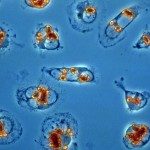Lien vers Pubmed [PMID] – 19923271
Lien DOI – 10.1242/jcs.055566
J Cell Sci 2009 Dec; 122(Pt 23): 4375-82
The conserved Aurora B protein kinase (Ipl1 in Saccharomyces cerevisiae) is essential for ensuring that sister kinetochores become attached to microtubules from opposite spindle poles (bi-orientation) before anaphase onset. When sister chromatids become attached to microtubules from a single pole, Aurora B/Ipl1 facilitates turnover of kinetochore-microtubule attachments. This process requires phosphorylation by Aurora B/Ipl1 of kinetochore components such as Dam1 in yeast. Once bi-orientation is established and tension is applied on kinetochores, Aurora B/Ipl1 must stop promoting this turnover, otherwise correct attachment would never be stabilised. How this is achieved remains elusive: it might be due to dephosphorylation of Aurora B/Ipl1 substrates at kinetochores, or might take place independently, for example because of conformational changes in kinetochores. Here, we show that Ipl1-dependent phosphorylation at crucial sites on Dam1 is maximal during S phase and minimal during metaphase, matching the cell cycle window when chromosome bi-orientation occurs. Intriguingly, when we reduced tension at kinetochores through failure to establish sister chromatid cohesion, Dam1 phosphorylation persisted in metaphase-arrested cells. We propose that Aurora B/Ipl1-facilitated bi-orientation is stabilised in response to tension at kinetochores by dephosphorylation of Dam1, resulting in termination of kinetochore-microtubule attachment turnover.


